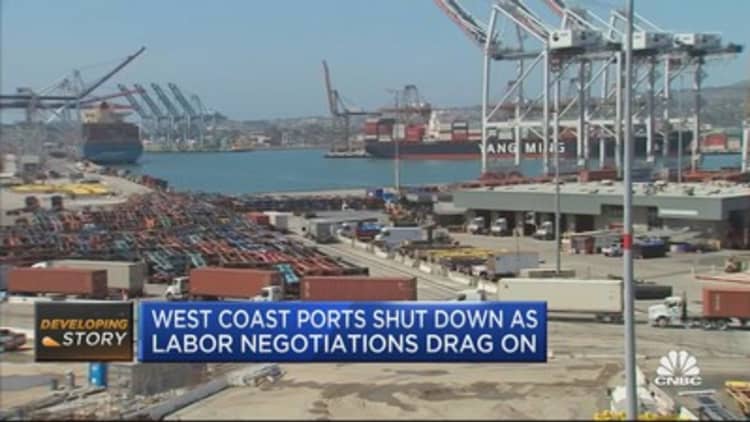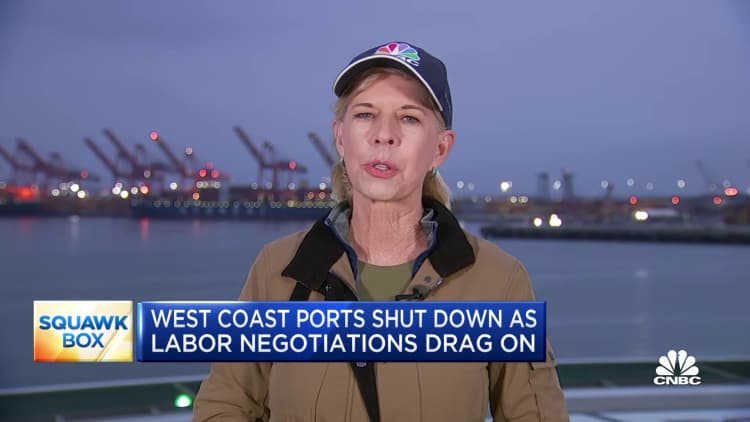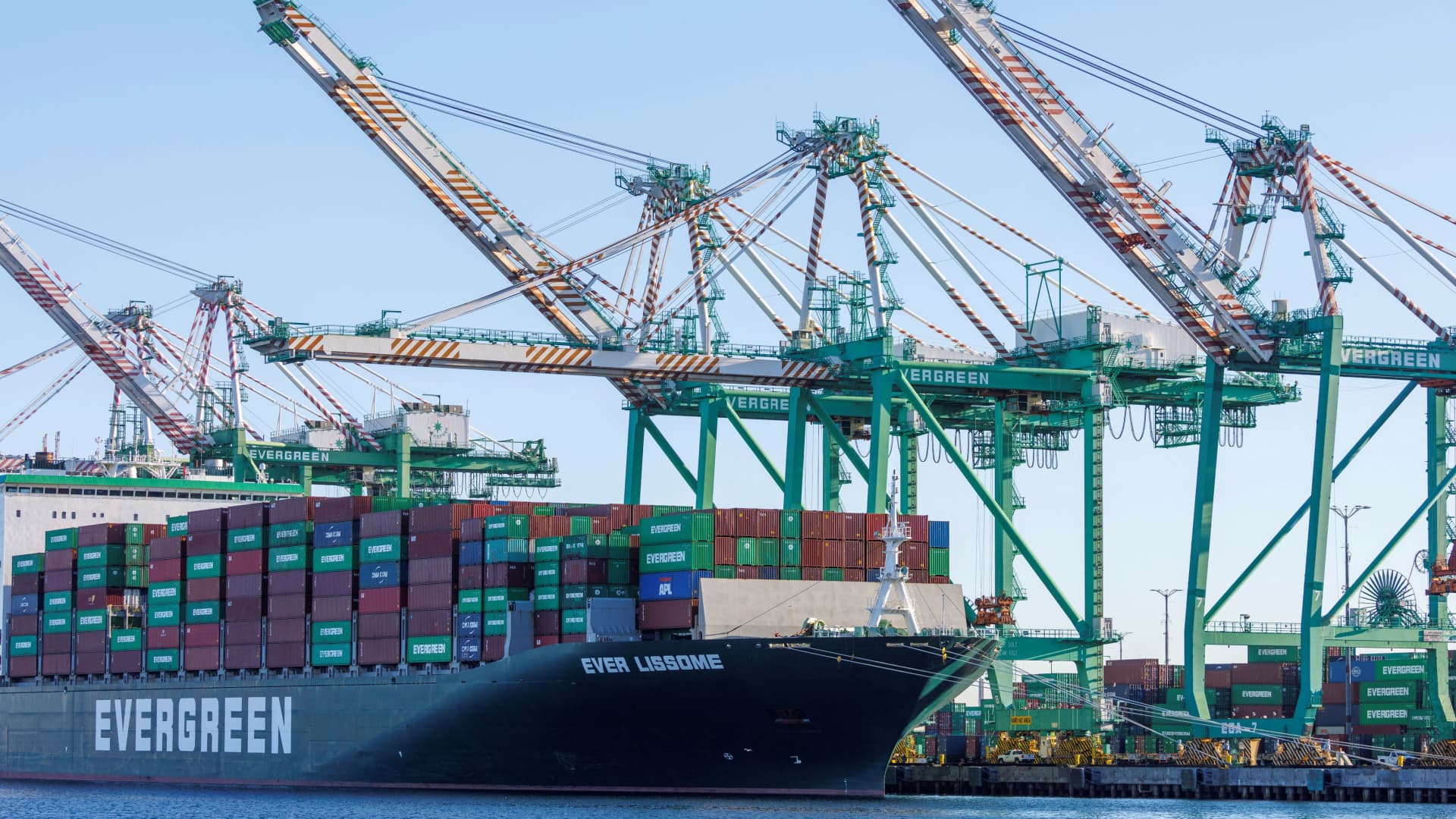A container ship is shown at the Port of Los Angeles in Los Angeles, California, November 22, 2021.
Mike Blake | Reuters
Just hours after the reopening of the West Coast ports on Monday after multiple closures that began at the Port of Oakland last Friday when some union workers refused to report for assignments, issues remain at select terminals within ports from Los Angeles to Seattle, with labor slowdowns and shift closures.
ITS Logistics tells CNBC its truckers were turned away by the terminal operator Fenix Marine Services, which is owned by ocean carrier CMA-CGM, at the Port of Los Angeles during the first shift Monday. They were picking containers from a variety of ocean carriers. Containers processed through the terminal include those owned by Maersk, OOCL, COSCO Shipping, Sealand (a Maersk company), and Evergreen.
“Navigating the ports on the entire West Coast over the last four days has been extremely frustrating for us and our clients,” said Paul Brashier, vice president of drayage and intermodal at ITS Logistics. “If it were not for updates from our drivers and our visibility software applications, we would not have even known about terminal closures Friday, throughout the weekend, and into today. Terminal announcements were severely lagging at best if they were issued at all, and announcements from the ILWU were misleading,” he said in a reference to the International Longshore and Warehouse Union, which has been engaged in a protracted battle over a new contract with port management.
Terminal alerts to trucking companies obtained by CNBC starting at 9:39am PT show some import appointments being canceled at Fenix Marine. Later in the morning, the dayside shift was cancelled, though Brashier learned of the cancellations earlier from his truckers who were turned away from picking up their containers.
Another Los Angeles Port terminal, Pacific Container Terminal (owned by SSA) announced Monday morning to truckers they would be closing the dayside shift on Tuesday. The terminal was already closed Monday for a scheduled closure which was announced approximately a week ago.

The Port of Los Angeles, the nation’s busiest port, processes $440 billion in cargo value per year. That market share has declined with more trade moving to the East Coast over the past year, at least partially due to labor issues on the West Coast that had supply chain managers worried about reliability of service. Recently, as the labor negotiations on the West Coast were said to have made progress, more trade started coming back. Port officials tell CNBC there are 52 vessels in route from China to the Port of Los Angeles, a number of vessels they have not seen since the diversion of trade to the East Coast and pullback in shipping orders. Oakland has also seen a recent increase in volume.
The Port of Long Beach is open and operating today after issues over the weekend, although two of its six container terminals were closed for the day shift. Operators of those terminals made the decision to close based on operational needs and were expected to reopen for the evening shift, the port said in a statement. TTI which closed the dayside shift Monday will open their second shift Monday afternoon but the appointments are light.
Port officials have stressed since Friday that they are operational, with select closures, and the ILWU said talks between the union and port management have not broken down. When issues began last Friday in Oakland, the union described actions by rank-and-file members to not show up for shift assignments as “voicing their displeasure.” The ports’ negotiation body, the Pacific Maritime Association, described it as coordinated union action.
On Monday, port sources said workers reported to assignments, but that slower than required performance led some workers to be relieved of duties. SSA Terminal in Seattle was reported to have released laborers working a vessel for not maintaining standard operating levels.
The ILWU and PMA are not commenting, citing a media blackout.

These operational disruptions have a cost to the supply chain and risk more damage to key sectors which ultimately flow through to consumer prices.
Sending drivers to ports on the off-chance that logistics companies may be able to get containers out either incurs dry-runs — when containers cannot be pulled — or congestion limits the amount of turns a driver can do in a day, Brashier explained. The congestion creates a situation where two or three extra truck drivers are needed to be hired to remove the containers stuck in congestion. “Both are charges that we do our best to avoid to prevent inflationary pressure throughout the supply chain,” he said. ITS Logistics is continuing to staff weekends and around the clock despite the new headwinds, he added.
The National Retail Federation issued a statement on Monday reiterating its position that the Biden Administration should intervene in the labor talks, worried delays could fuel inflation and impact the delivery of products during peak shipping season which runs from July to October, covering back-to-school and holiday seasons.
“It is imperative that the parties return to the negotiating table. We urge the administration to mediate to ensure the parties quickly finalize a new contract without additional disruptions,” said David French, senior vice president of government relations at NRF in a statement.
Project44, a CNBC Supply Chain Heat Map provider, tells CNBC the ongoing labor disruptions at ports along the West Coast will cause significant repercussions on global supply chains if not solved promptly.
MarineTraffic, a CNBC Supply Chain Heat Map data provider analyzed he vessels traveling from China to the ports of Los Angeles and Long Beach and identified some vessels loitering in the water awaiting to dock at the Port of Los Angeles. The MSC Jeongmin was seen leaving the Port of Oakland, traveling down the coast of California, and then stopping in the open waters off of Santa Barbara where it proceeded to circle in place.
With a 40% share of imports flowing into the U.S. passing through these ports, persistence of terminal shutdowns will trigger reduced inventories and a continued shift away from West Coast ports to ports like New York, said Jenna Slagle, senior data analyst with with Project44.
“These additional disruptions will force retailers and other important shipping partners to continue to shift cargo away from the West Coast ports until a new labor contract is established,” French said.
The current labor strife already has impacted the delivery of containers at ports where issues have arisen.
Container wait times for the ports of Long Beach and Los Angeles are both experiencing a slight increase in dwell times.
North of the ports of LA and Long Beach, the Port of Oakland has seen the most impact as it relates to container wait times.
On Monday, the Port of Oakland’s marine terminals were operational, said Robert Bernardo, spokesman for the port.


